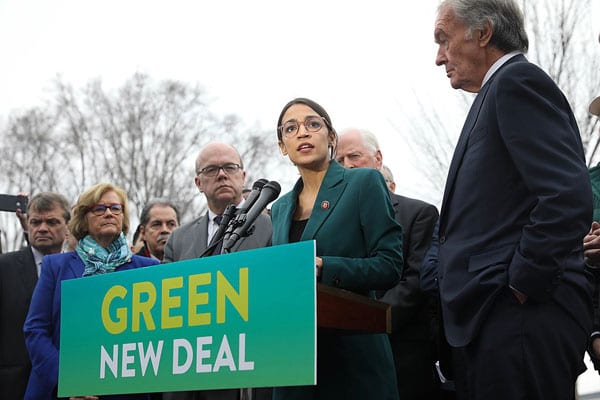
February 7, 2019; Vox
Since the 2018 elections, calls for a Green New Deal have gained ground. Last December, Alexandria Ocasio-Cortez (D-NY) called the Green New Deal “the moon shot, the civil-rights movement of our generation.”
But what might it look like? Many questions remain, but a bill introduced last week by Sen. Ed Markey (D-MA) and Ocasio-Cortez “lays out the goals, aspirations, and specifics of the program in a more definitive way,” writes David Roberts in Vox. The bill text in 14 pages provides an outline of what a Green New Deal might look like.
The resolution contains four sections: First, a preamble highlights the dual challenge of climate change and economic inequality; second, a list of five primary goals; then, a list of 14 climate projects; and, finally, a list of 15 equity principles to guide the work.
The bill is designed to be a sketch. Notably, it does not propose to budget funds. In essence, the bill seeks to outline goals and guide future legislation.
Still, the bill plays an important role in making more specific what a Green New Deal, if enacted down the road, might look like. The five main goals are:
(A) to achieve net-zero greenhouse gas emissions through a fair and just transition for all communities and workers;
(B) to create millions of good, high-wage jobs and ensure prosperity and economic security for all people of the United States;
(C) to invest in the infrastructure and industry of the United States to sustainably meet the challenges of the 21st century;
(D) to secure for all people of the United States for generations to come—
Sign up for our free newsletters
Subscribe to NPQ's newsletters to have our top stories delivered directly to your inbox.
By signing up, you agree to our privacy policy and terms of use, and to receive messages from NPQ and our partners.
(i) clean air and water;
(ii) climate and community resiliency;
(iii) healthy food;
(iv) access to nature; and
(v) a sustainable environment; and
(E) to promote justice and equity by stopping current, preventing future, and repairing historic oppression of indigenous peoples, communities of color, migrant communities, deindustrialized communities, depopulated rural communities, the poor, low-income workers, women, the elderly, the unhoused, people with disabilities, and youth (referred to in this resolution as “frontline and vulnerable communities”)
To achieve these goals, the legislation calls for a 10-year national mobilization to work on the aforementioned 14 projects. These are:
- Building resiliency against climate change-related disasters
- Repairing and upgrading the infrastructure
- Expanding the use of “clean, renewable and zero-emission” sources of power with the goal of zeroing out fossil fuel sources
- Creating energy-efficient, distributed, and “smart” power grids
- Maximizing water and energy efficiency in new buildings and by retrofitting existing buildings
- Removing pollution and greenhouse gas emissions from industry as much as is technologically feasible
- Working collaboratively with farmers and ranchers to remove pollution and greenhouse gas emissions from the agricultural sector as much as is technologically feasible
- Overhauling transportation systems to remove pollution and greenhouse gas emissions from the transportation sector as much as is technologically feasible
- Mitigating and managing adverse health and economic effects of pollution and climate change, including by providing funding for community-based solutions
- Removing greenhouse gases and restoring natural ecosystems through proven low-tech solutions that increase soil carbon storage, such as land preservation and reforestation
- Restoring and protecting fragile ecosystems by enhancing biodiversity
- Cleaning up existing hazardous waste and abandoned sites
- Identifying other pollution sources and creating solutions to remove them
- Promoting the international exchange of technology and expertise to meet climate goals
The last section of the bill focuses on equity. The legislation states that “a Green New Deal must be developed through transparent and inclusive consultation, collaboration, and partnership with frontline and vulnerable communities, labor unions, worker cooperatives, civil society groups, academia, and businesses.”
Among the more ambitious equity objectives, notes Roberts, is a federal job guarantee, a feature that Robinson Meyer argued in the Atlantic is essential to making the Green New Deal politically viable, as it counters destabilizing aspects of addressing climate change (such as winding down fossil fuel industries). Certainly, Green New Deal infrastructure could generate considerable employment. A study last year by Greg Carlock and Emily Mangan, published by Data for Progress, argues it could generate 10 million jobs in 10 years.
Of course, advocates still have their work cut out for them. Still, Roberts notes that the legislation introduced by Markey and Ocasio-Cortez is “wildly more ambitious than anything the Democratic Party was talking about even two years ago….There’s a long way to go, but the Green New Deal train has come farther, faster than anyone could have predicted.”—Steve Dubb











